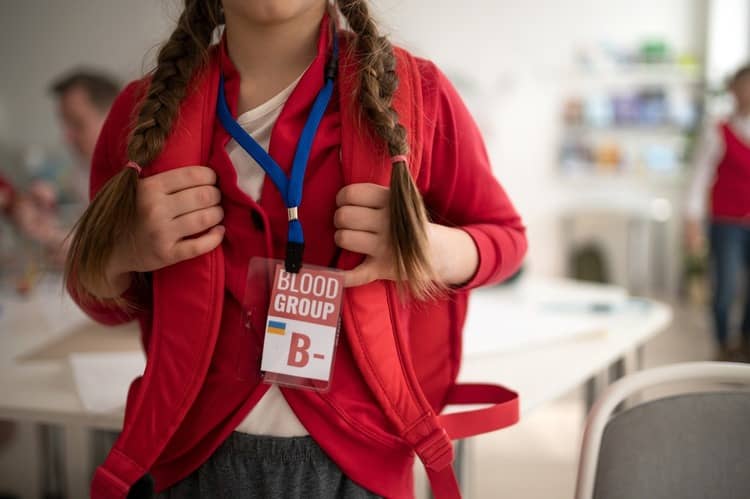
What blood types cannot have babies together? How to find out the child's blood type + table
What the parents' blood types are determines what blood type their child will have. However, expectant parents are often interested not only in how to find out the child's blood group, but also in which blood groups are compatible. Even the blood groups of the partners can influence the course of pregnancy, its riskiness, as well as the development of the fetus itself. The role is played not only by the classic division of blood groups A, B, AB and 0, but above all by the Rh (Rhesus) factor, which is Rh positive in more than 85% of the population and Rh negative in only about 15% of the population. What role does the Rh factor play in pregnancy? Why is blood type determination important? Which combination of blood types is the worst and which is the best?
In most cases, a person usually meets the blood group when donating, or blood transfusion in the event of a serious injury or during an operation where there is blood loss in the patient. It does not matter what blood type a person accepts. No less important is this blood alchemy in a woman's pregnancy. A child can inherit the blood group from the father or from the mother. After fertilization of a woman's egg by a man's sperm and successful implantation, the fetus receives half of its genetic makeup from the father and half from the mother. The formation of a child's blood group is therefore always made up of two genes. Blood groups and their inheritance have their principles, but also certain exceptions. In which case is partner compatibility guaranteed? Is it a problem if the mother is Rh positive and the father is Rh negative ?
AB0 blood groups
The division of blood groups according to AB0 represents the most basic classification for characterizing the properties of red blood cells (erythrocytes). However, know that there are more than 50 other blood type classification systems in this field of medicine. It is important that on the surface of red blood cells, in the case of red blood cells, there is an antigen (immunogen) that ensures the formation of antibodies (note that blood type 0 is an exception). Antigen as such is represented by a certain protein, or protein and polysaccharide. According to the AB0 categorization, we know four blood groups :
- blood group A, antigen A, antibody anti-B,
- blood group B, antigen B, antibody anti-A,
- blood group AB, antigens AB, without antibodies,
- blood group 0, without antigens, anti-A and anti-B antibodies.
In the world, based on the regions and the human race, we can encounter a different ratio of occurrence of AB0 antigens. Blood type A (42%) is predominant in Slovakia, followed by blood type 0 (38%) and then B (13%) and AB (7%). In Nigeria or Paraguay, more than 55% of the population has blood type 0. At the same time, blood group 0 is the most represented worldwide. However, the components of blood are not only red blood cells, which primarily distribute oxygen in the body, but also white blood cells, which are essential for the immune system, blood plasma, which transports proteins and salts in the body, and last but not least, blood platelets, whose role is to ensure blood clotting.

Blood groups - combinations
The combination of blood groups has certain principles and it is a proven possibility to find out the blood group of the child. The rules of blood group inheritance are always based on two genes - from the mother and from the father. After their fusion, one gene with three alleles is created. In general, genes of blood groups A and B are generally stronger, blood group 0 has a weaker gene. There are different variations of the gene and this gives rise to different genotypes. If, for example, A and B meet, the so-called codominance and no single gene predominates and therefore occur at the same time. However, with regard to the regional distribution of the population, the genotypes differ, therefore the ratio of blood groups is different in different regions of the world.

Blood type and Rh positive or Rh negative
A very important element in the blood group system is the Rh factor. The Rhesus factor was named after the monkeys - macaques (Rhesus Macaque), in which this element was discovered. This factor differentiates whether the blood group or the blood of an Rh positive or Rh negative individual. If the Rh factor is positive, it contains the Rh antigen, if it is Rh negative, it does not contain the Rh factor. Worldwide, Rh+ prevails in 85% of the population, and Rh- occurs in only about 15% of people in the world.
The Rh factor is made up of a wider group of 50 antigens, while from the point of view of blood group inheritance, the most important antigen is D. If red blood cells have D antigen on their surface, the blood group is designated as Rh+, on the contrary, if D antigen is not present, the blood group is designated as Rh-. This insight is also important for blood transfusion, a person with Rh- (without D antigen) cannot receive blood from an Rh+ donor, because the body would start to create natural antibodies, which poses a risk and even a life-threatening condition. Shock, organ failure or even death can occur. It is alchemy in connection with the Rh factor that can play a role in pregnancy. It mainly concerns women who have already given birth. In first-time mothers, the problem of blood incompatibility appears only very rarely.
Child's blood group and Rh factor
The Rh factor designation clearly defines whether the D-antigen is present in the individual's blood – A+, A-, B+, B-, AB+, AB-, 0+, 0-. Certain cases of heredity and determination of a child's blood type require increased attention. The risk is if the child's blood group is Rh+, while the mother's blood group is Rh-, i.e. without D-antigen. Since the mother's body does not contain this antigen, it starts an immune reaction and creates antibodies against the blood of the fetus - the baby. This can endanger the developing fetus, but this condition also poses a risk for the mother herself. In the past, the problem of blood incompatibility was a frequent cause of miscarriage or death of newborns. Today there is a successful therapy that eliminates this risk. What is the inheritance of the Rh +/- factor when it is combined?

What does a positive baby mean for a pregnant woman?
It is very important for a gynecologist to know the Rh factor of a pregnant woman. As you can see in the table above, if the father is, for example, Rh+ positive and the mother is Rh- negative, the child can have either the Rh+ or Rh- factor. In certain circumstances, complications can occur, if the mother is Rh- and the child has the Rh+ blood group. If the Rh-D antigen is not found in the woman, but the child's blood contains it, hemolytic disease of the fetus or newborn may develop. In such a case, the Rh- blood group starts an immune reaction against the blood of the fetus, which has an Rh+ positive factor and contains the D-antigen.
However, the development of this disease can also occur in pregnant women with the Rh+ factor, so antibody levels should be checked with an antiglobulin test in all circumstances. Blood group 0 is the most sensitive for these cases in circumstances where the child has a blood group other than 0. In high-risk cases, it is good to have the level of antibodies determined in the laboratory at certain intervals at least twice during pregnancy, e.g. in the 12th week and the 28th week. Optionally, three times at 34 weeks to give anti-D antibodies.
Rh factor and pregnancy - the problem of incompatibility
If Rh incompatibility is detected during pregnancy, what happens is that the mother's body creates antibodies against the blood cells of the fetus. This causes blood cells to break down (hemolysis). Antibody monitoring is therefore enormously important in order to be able to diagnose the severity of the condition and possibly administer anti-D antibodies. If the fetus cannot deal with the loss of blood cells and this condition is neglected, it can cause anemia or loss of oxygen to the fetus, because the red blood cells of the fetus will be missing and the transport of oxygen through the placenta will not be possible. Death of the fetus or development of hemolytic disease in the newborn may occur.
At critical values, it is necessary to diagnose the fetus in order to prevent further development of the disease. By pricking the umbilical cord - cordocentesis, fetal blood is taken and a blood count is taken. Alternatively, an examination of the amniotic fluid - amniocentesis - can be performed. In extreme cases, intrauterine transfusion of fetal blood is even possible. After the birth of a baby who has lost the amount of red blood cells, phototherapy under UV light is carried out or immunoglobulins are administered intravenously, which reduces the rate of breakdown of blood cells.

Risk in the next pregnancy
This problem of incompatibility is paradoxically rare in the first pregnancy, and such complications occur only very rarely in first-time mothers. However, if the first-time mother is Rh-D negative, in order to avoid complications in a possible future pregnancy, it is possible to give the pregnant woman an injection containing anti-D globulin (Rhega) in the 28th week of pregnancy. It contains antibodies that bind Rh+ blood cells to each other and thus prevent further influence on the mother's body, as well as the formation of antibodies against Rh+ blood. After birth, it is advisable to check the child's Rh factor, if the child is Rh+ positive, the mother is given a second dose of Rhega injection within 72 hours. In gynecological practice, there are still few gynecologists who implement such prophylaxis, and it is usually resolved if the problem occurs during pregnancy.
The reason why such prophylaxis is appropriate is that during the first birth, the blood of the mother and the child can mix, which can subsequently lead to the formation of antibodies against the D antigen. The antibodies then remain in the mother's body, and this process can cause problems for the next pregnancy, if the fetus is Rh+ positive.
The medicine containing anti-D globulin should be administered to a woman with the Rh factor even if such a pregnancy ended in the death of the fetus (spontaneous abortion) or if the diagnostic results of the pregnant woman showed a suspicion of the risk of a genetic defect in the child. In such a case, amniocentesis was performed, which is the collection of amniotic fluid, from which genetic material is subsequently analyzed. Some doctors also recommend Rhega injection to women after an ectopic pregnancy or abortion.
Experiences
Women on the Internet also decide what blood groups cannot have children together. According to them, the same Rh factor is fine. Parents can both have the same blood type and the same Rh factor and have a child without problems. The problem is a different Rh factor, for example, if the mother is Rh negative and the father is Rh positive. In that case, increased attention is necessary.
The most frequent questions - FAQ
Is the topic of blood groups interesting or current for you? Do you want to know when blood groups are at risk? What does it mean if blood type B is negative or blood type 0 Rh+? We believe that thanks to our article you will learn everything important. We will also be happy if you share your experiences, advice and recommendations with us, which can significantly help other readers - mothers.
What does it mean if the parents are of the same blood type?
What blood groups cannot have children together?
What is the worst blood type?
What is AB0 incompatibility?
How much blood is there in the human body?
Pridať komentár





